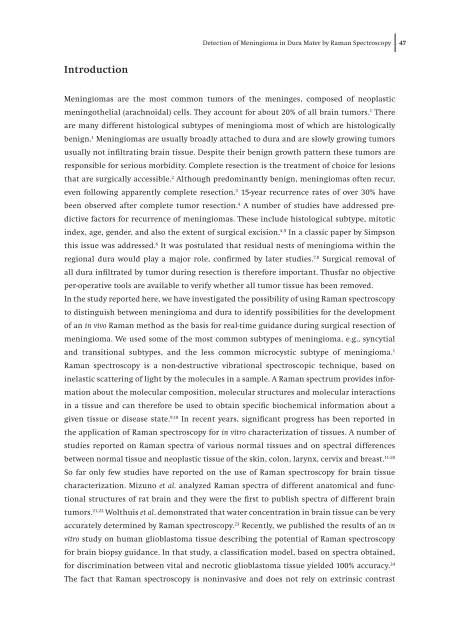Towards clinico-pathological application of Raman spectroscopy
Towards clinico-pathological application of Raman spectroscopy
Towards clinico-pathological application of Raman spectroscopy
Create successful ePaper yourself
Turn your PDF publications into a flip-book with our unique Google optimized e-Paper software.
Introduction<br />
Detection <strong>of</strong> Meningioma in Dura Mater by <strong>Raman</strong> Spectroscopy<br />
Meningiomas are the most common tumors <strong>of</strong> the meninges, composed <strong>of</strong> neoplastic<br />
meningothelial (arachnoidal) cells. They account for about 20% <strong>of</strong> all brain tumors. 1 There<br />
are many different histological subtypes <strong>of</strong> meningioma most <strong>of</strong> which are histologically<br />
benign. 1 Meningiomas are usually broadly attached to dura and are slowly growing tumors<br />
usually not infiltrating brain tissue. Despite their benign growth pattern these tumors are<br />
responsible for serious morbidity. Complete resection is the treatment <strong>of</strong> choice for lesions<br />
that are surgically accessible. 2 Although predominantly benign, meningiomas <strong>of</strong>ten recur,<br />
even following apparently complete resection. 3 15-year recurrence rates <strong>of</strong> over 30% have<br />
been observed after complete tumor resection. 4 A number <strong>of</strong> studies have addressed predictive<br />
factors for recurrence <strong>of</strong> meningiomas. These include histological subtype, mitotic<br />
index, age, gender, and also the extent <strong>of</strong> surgical excision. 4,5 In a classic paper by Simpson<br />
this issue was addressed. 6 It was postulated that residual nests <strong>of</strong> meningioma within the<br />
regional dura would play a major role, confirmed by later studies. 7,8 Surgical removal <strong>of</strong><br />
all dura infiltrated by tumor during resection is therefore important. Thusfar no objective<br />
per-operative tools are available to verify whether all tumor tissue has been removed.<br />
In the study reported here, we have investigated the possibility <strong>of</strong> using <strong>Raman</strong> <strong>spectroscopy</strong><br />
to distinguish between meningioma and dura to identify possibilities for the development<br />
<strong>of</strong> an in vivo <strong>Raman</strong> method as the basis for real-time guidance during surgical resection <strong>of</strong><br />
meningioma. We used some <strong>of</strong> the most common subtypes <strong>of</strong> meningioma, e.g., syncytial<br />
and transitional subtypes, and the less common microcystic subtype <strong>of</strong> meningioma. 1<br />
<strong>Raman</strong> <strong>spectroscopy</strong> is a non-destructive vibrational spectroscopic technique, based on<br />
inelastic scattering <strong>of</strong> light by the molecules in a sample. A <strong>Raman</strong> spectrum provides information<br />
about the molecular composition, molecular structures and molecular interactions<br />
in a tissue and can therefore be used to obtain specific biochemical information about a<br />
given tissue or disease state. 9,10 In recent years, significant progress has been reported in<br />
the <strong>application</strong> <strong>of</strong> <strong>Raman</strong> <strong>spectroscopy</strong> for in vitro characterization <strong>of</strong> tissues. A number <strong>of</strong><br />
studies reported on <strong>Raman</strong> spectra <strong>of</strong> various normal tissues and on spectral differences<br />
between normal tissue and neoplastic tissue <strong>of</strong> the skin, colon, larynx, cervix and breast. 11-20<br />
So far only few studies have reported on the use <strong>of</strong> <strong>Raman</strong> <strong>spectroscopy</strong> for brain tissue<br />
characterization. Mizuno et al. analyzed <strong>Raman</strong> spectra <strong>of</strong> different anatomical and functional<br />
structures <strong>of</strong> rat brain and they were the first to publish spectra <strong>of</strong> different brain<br />
tumors. 21,22 Wolthuis et al. demonstrated that water concentration in brain tissue can be very<br />
accurately determined by <strong>Raman</strong> <strong>spectroscopy</strong>. 23 Recently, we published the results <strong>of</strong> an in<br />
vitro study on human glioblastoma tissue describing the potential <strong>of</strong> <strong>Raman</strong> <strong>spectroscopy</strong><br />
for brain biopsy guidance. In that study, a classification model, based on spectra obtained,<br />
for discrimination between vital and necrotic glioblastoma tissue yielded 100% accuracy. 24<br />
The fact that <strong>Raman</strong> <strong>spectroscopy</strong> is noninvasive and does not rely on extrinsic contrast<br />
47

















